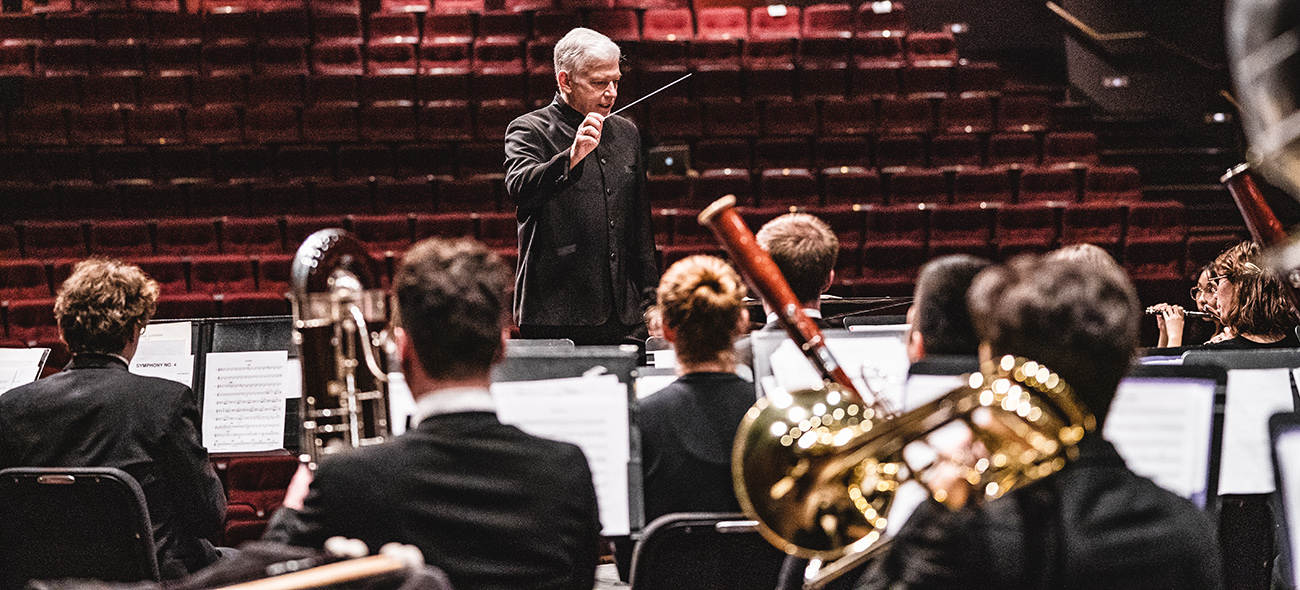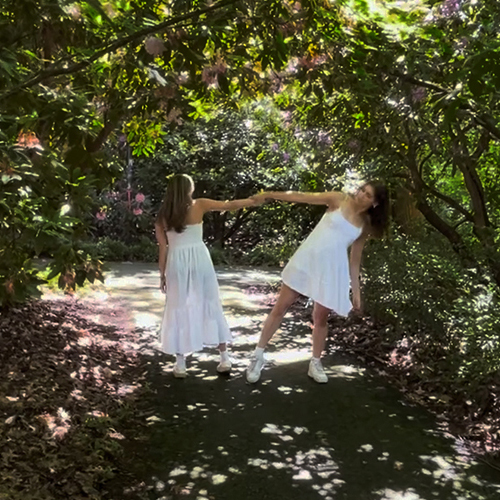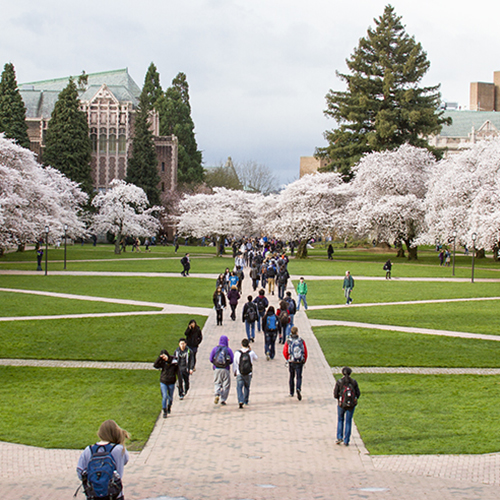Timothy Salzman had big plans for the UW Wind Ensemble for 2020. He had organized the 54-member ensemble’s first-ever tour of South Korea, with performances scheduled in three Korean cities over spring break. Then the coronavirus hit and the trip was canceled. Before long, Wind Ensemble on-campus rehearsals and concerts were canceled as well, as all UW faculty were required to teach their courses remotely.
“It was gut-wrenching,” recalls Salzman, professor of music, director of concert bands, and conductor of the Wind Ensemble in the UW School of Music. “We’d put together a wonderful program for Korea. Not only did the students not get to go, but nearly two hours of music we had lovingly prepared never got to see the light of day. When it was clear faculty would be teaching remotely during spring quarter, I racked my brain about what to do.”

Salzman quickly pivoted, thinking about aspects of music he never had time to teach in his performance-based class. Then he called Alex Shapiro, a composer from Friday Harbor whose works incorporate natural and electronic sounds. “I told her, ‘I just got this crazy idea. Is it feasible? Is the technology there?’ We batted ideas around for 90 minutes. The next day she sent me a five-page course syllabus.”
The ideas Salzman and Shapiro discussed became the core of Salzman’s spring quarter Wind Ensemble course, with a focus on improvisation and composition. “I think having improvisation experience makes you a more poised and more flexible performer,” Salzman says. “And understanding composition helps you think about form and intention in music in a way you don’t necessarily do when you’re playing your single line on your instrument in an ensemble.”
I told her, ‘I just got this crazy idea. Is it feasible? Is the technology there?’
Students in Salzman’s online class have been tasked with recording short passages of improvised music at home, and then working remotely in small teams of five to nine students to combine and modify their recordings into something layered and nuanced with the use of readily available recording and mixing software. Salzman believes that by manipulating sound — shortening or lengthening passages, juxtaposing them in different ways, making them more dense or transparent — his students can add shape to their music, a sense of tension and release. “That’s where negotiations and artistic input become critical,” he says.
To deepen students’ understanding of composition, seven successful composers are meeting with the class as guest speakers. The students prepare for each conversation by listening to the composer’s work; in online discussions, the guests share their approach to composing and their professional journey in music. Alex Shapiro was the first guest; others include School of Music professors Richard Karpen and Huck Hodge and other renowned US composers including Marty O’Donnell, composer of the soundtracks to the Halo and Destiny video games.

A common theme for the composers has been their jagged path to professional success, with many disappointments and setbacks along the way. The message resonated with students preparing to embark on their own music careers. “Those conversations made me recognize that it takes people years to figure out who they are and what they are about,” says bassoon major Lucas Zeiter, who will graduate in June. “I hope to eventually achieve my dreams, but I have accepted that it may take longer than I think to get there.”
Rachel Reyes, a senior majoring in flute, was particularly inspired by the guest speakers’ creative processes. She recalls how Hodge encouraged students to tap into sounds that are often overlooked — the sound of vending machines, for example — and how Shapiro visually sketches out her ideas for compositions.

Many Wind Ensemble students had little experience composing before this course, and even less experience with the music software required for their composition assignments. Fortunately teaching assistant Chris Mathakul, a Wind Ensemble member and doctoral student in wind conducting, created tutorials to help less experienced students get started with music recording and mixing. “With the availability of technology, musicians can do everything they need to do themselves to put their music out there,” says Mathakul. “Of course that means it’s important to learn how to use available tools in the best possible way, to keep up with everyone else.”
Several weeks into the class, Reyes was already embracing the opportunity to learn a new set of skills, despite initial misgivings. “I tend to be a perfectionist, so I was worried about my part of the project not being good enough,” she says. “But listening to all these accomplished composers encouraging us to just take the first step encouraged me to get out of my head and just make music.”
Salzman has had to take a leap of his own, embarking on a totally new approach to teaching after 33 years at the University. This foray into uncharted territory has been both frustrating and exhilarating. “The best way I can describe it is that I feel like Magellan,” Salzman says. “It’s like we heard there’s land out there to the West and we got in a boat to find out, hoping there's actually land over there. We're definitely feeling our way forward in the dark.”
The course is still evolving. As students gain confidence in recording and mixing music, they may be improvising longer passages for more ambitious group compositions. There may be finished pieces to share with the public by the end of the quarter. (Two works-in-progress are included below.) Salzman is pleased with the students’ progress, though they all look forward to a day when they can make music together in person.
“The Wind Ensemble has been my second family and I was so looking forward to all the great concerts and the South Korea tour we had planned for the year,” says Reyes. “While nothing can truly replace rehearsing and performing with the ensemble in person, I’ve really appreciated just how quickly Professor Salzman, his conducting cohort, and Alex Shapiro have created this completely new class experience for us. It’s been great to see all my peers continuing with the course despite the challenges, with excitement for this new project.”
. . .
Learn more about the University of Washington Wind Ensemble.
More Stories

Democracy by the Numbers
Mathematics and Democracy, an undergraduate mathematics course, explores the role of math in many aspects of democracy, from elections to proportional representation.

Dancing Across Campus
For the dance course "Activating Space," students danced in public spaces across the University of Washington's Seattle campus this spring.

Four Students Shine as 2024 Dean's Medalists
Meet the four new graduates honored as College of Arts & Sciences Dean's Medalists for 2024.